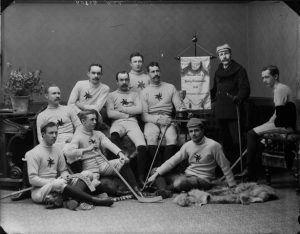
Photo Credit: WJ Topley. LAC MIKAN 3386124
The game of hockey was not invented in Ottawa but it has deep roots in the city, including in Sandy Hill. In 1887, a group of investors incorporated the Rideau Skating and Curling Club and raised $10,000 to erect a permanent covered rink for “the encouragement of skating, curling and other amusements” (quoted in Uren, 2003, p 5). The rink was in fact two adjoining structures, a skating rink giving onto Theodore St. (now Laurier Ave. E.) and a curling rink with its main entrance on Waller St. The Club quickly became a popular gathering place for the City’s elite: the Governor General, Lord Stanley, was an investor; C.T. Bate, the first president of the Rideau Skating and Curling Company, was a wealthy merchant and a former mayor; Sir Sandford Fleming was the first president of the Rideau Curling Club, leaving the older Ottawa Club to which he belonged because of its temperance policies.
The rink opened formally on February 1, 1889, Ottawa’s first senior hockey team, the Ottawa Hockey Club, being the main tenant over the first few years. In 1890, it paid an annual rent of $20 for the season plus half the gross proceeds from matches, after advertising. Although this sum looks laughably small today, the Club still lost money that year.
It has to be said that hockey then was a very different sport from what we know today: The ice was natural, not artificial and was entirely weather-dependent. There were seven players on the ice, all amateurs, who wore less equipment than today’s players and only limited substitutions were allowed; forward passes were forbidden and the goals initially had no nets which understandably led to controversy when it came to scoring.
For three years, between 1891 and 1894, Ottawa played in two separate leagues: the Amateur Hockey Association of Canada, based in Montreal and the Ontario Hockey Association based in Toronto. Beside being physically based in Sandy Hill, the Ottawa Hockey Club had other associations with the neighbourhood. Llewellyn Bate, one of C.T. Bate’s nephew’s and a son of Sir Henry Bate who built All Saints Church, served on the management of the Ottawa Hockey Club and lived on Wilbrod Ave. Some of the hockey players, including Frank McGee, one of the best players of his generation, also lived in Sandy Hill[1]. So did one of the trustees of the Stanley Championship Trophy (the Stanley Cup), awarded to the top hockey team in Canada, Phil Ross, who lived in Sandy Hill most of his life and was also the editor of the Ottawa Journal and for a time for the Hockey Club’s manager. The second Stanley Cup trustee was the Sheriff of Carleton County, Dr. John Sweetland, after whom Sandy Hill’s Sweetland Ave. is named.
[1] Individual profiles on Sir Henry Bate, Sir Sandford Fleming, Phil Ross and Frank McGee can be found on this website.
Sources
Paul Kitchen (2008) Win, Tie or Wrangle – The Inside Story of the Old Ottawa Senators 1883 -1935 (Penumbra Press, Manotick)
